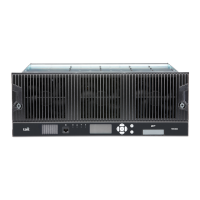68 Installation TB9300 Installation and Operation Manual
© Tait International Limited April 2024
4.4.7 Tuning the Reciter
The following table indicates which bands are manually tuned and which
are electronically tuned:
B2 and B3 Bands
C Band
Before the base station is installed on site, you may need to tune the
receiver front end. The receiver front end requires tuning if the receive
frequency has shifted more than 2MHz away from the previously set
frequency, or if the RSSI level of the new frequency is more than 1dB
lower than the RSSI level of the previously set frequency.
The base station receiver signal level diagnostic (Diagnose > RF Inter-
face > Signal Level) offers the ability to verify that the configured
receiver frequency aligns with the receiver tuning.
When the frequency sweep is set to “Use calibrated noise source”, the
resulting curve represents the receiver front end response, and provides
a quick visual check of whether the receiver is optimally tuned. A well
tuned receiver should have the maximum response at the operating fre-
quency. See the online help for more details.
The receiver in the B-band reciter covers one of the following frequency
bands, depending on the model:
■ B2 - 136 to 156 MHz
■ B3 - 148 to 174 MHz
■ C1 - 174 to 193 MHz
■ C3 - 216 to 225 MHz
The B and C1 band frequencies are split into 2 sub-bands:
Band Manual Electronic
B2 ✓✗
B3 ✓✗
C1 ✓✗
C3 ✓✗
H1 ✓✗
H2 ✓✗
H3 ✓✗
H4 ✗✓
H5 ✗✓
K4 ✗✓
K8 ✗✓
L2 ✗✓
G4 ✗✓

